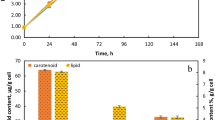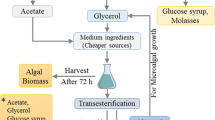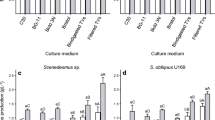Abstract
In this study, Rhodosporidium toruloides and Tetradesmus obliquus were used for lipid and carotenoid production in mixed cultures using primary brewery wastewater (PBWW) as a culture medium, supplemented with sugarcane molasses (SCM) as a carbon source and urea as a nitrogen source. To improve biomass, lipid, and carotenoid production by R. toruloides and T. obliquus mixed cultures, initial SCM concentrations ranging from 10 to 280 g L−1 were tested. The medium that allowed higher lipid content (26.2% w/w dry cell weight (DCW)) and higher carotenoid productivity (10.47 µg L−1 h−1) was the PBWW medium supplemented with 100 g L−1 of SCM and 2 g L−1 of urea, which was further used in the fed-batch mixed cultivation performed in a 7-L bioreactor. A maximum biomass concentration of 58.6 g L−1 and maximum lipid content of 31.2% w/w DCW were obtained in the fed-batch cultivation. PBWW supplemented with SCM was successfully used as a low-cost medium to produce lipids and carotenoids in a R. toruloides and T. obliquus mixed culture, with higher productivities than in pure cultures, which can significantly reduce the cost of the biofuels obtained.






Similar content being viewed by others
Data Availability
The datasets generated during and/or analyzed during the current study are available from the corresponding author upon reasonable request.
References
Dias, C., Sousa, S., Caldeira, J., Reis, A., & Lopes da Silva, T. (2015). New dual-stage pH control fed-batch cultivation for the improvement of lipids and carotenoids production by the red yeast Rhodosporidium toruloides NCYC 921. Bioresource Technology, 189, 309–318.
Ling, J., Nip, S., Cheok, W. L., Toledo, R. A., & Shim, H. (2014). Lipid production by a mixed culture of oleaginous yeast and microalga from distillery and domestic mixed wastewater. Bioresource Technology, 173, 132–139.
Cho, H. U., & Park, J. M. (2018). Biodiesel production by various oleaginous microorganisms from organic wastes. Bioresource Technology, 256, 502–508.
Dias, C., Santos, J., Reis, A., & Lopes da Silva, T. (2019). Yeast and microalgal symbiotic cultures using low-cost substrates for lipid production. Bioresource Technology Reports, 7, 100261.
Liang, M. H., & Jiang, J. G. (2013). Advancing oleaginous microorganisms to produce lipid via metabolic engineering technology. Progress in Lipid Research, 52, 395–408.
Qin, L., Liu, L., Zeng, A. P., & Wei, D. (2017). From low-cost substrates to single cell oils synthesized by oleaginous yeasts. Bioresource Technology, 245, 1507–1519.
Gouveia, L., Oliveira, A. C., Congestri, R., Bruno, L., Soares, A. T., Menezes, R. S., Filho, N. R. A., & Tzovenis, I. (2018). Biodiesel from microalgae. In C. Gonzalez-Fernandez & R. Muñoz (Eds.), Microalgae-based biofuels and bioproducts: From feedstock cultivation to end-products (pp. 235–258). Woodhead Publishing.
Zhang, K., Zheng, J., Xue, D., Ren, D., & Lu, J. (2017). Effect of photoautotrophic and heteroautotrophic conditions on growth and lipid production in Chlorella vulgaris cultured in industrial wastewater with the yeast Rhodotorula glutinis. Journal of Applied Phycology, 29, 1–6.
Dias, C., Reis, A., Santos, J. A. L., & Lopes da Silva, T. (2020). Concomitant wastewater treatment with lipid and carotenoid production by the oleaginous yeast Rhosdosporidium toruloides grown on brewery effluent enriched with sugarcane molasses and urea. Process Biochemistry, 94, 1–14.
Schneider, T., Graeff-Hönninger, S., French, W. T., Hernandez, R., Merkt, N., Claupein, W., Hetrick, M., & Pham, P. (2013). Lipid and carotenoid production by oleaginous red yeast Rhodotorula glutinis cultivated on brewery effluents. Energy, 61, 1–10.
Marchão, L., Lopes da Silva, T., Gouveia, L., & Reis, A. (2018). Microalgae-mediated brewery wastewater treatment: Effect of dilution rate on nutrient removal rates, biomass biochemical composition, and cell physiology. Journal of Applied Phycology, 30, 1583–1595.
Dias, C., Reis, A., Santos, J. A. L., Gouveia, L., & Lopes da Silva, T. (2022). Primary brewery wastewater as feedstock for the yeast Rhodosporidium toruloides and the microalga Tetradesmus obliquus mixed cultures with lipid production. Process Biochemistry, 113, 71–86.
Dias, C., Gouveia, L., Santos, J. A. L., Reis, A., & Lopes da Silva, T. (2020). Using flow cytometry to monitor the stress response of yeast and microalgae populations in mixed cultures developed in brewery effluents. Journal of Applied Phycology, 32, 3687–3701.
Dias, C., Silva, C., Freitas, C., Reis, A., & Lopes da Silva, T. (2016). Effect of medium pH on Rhodosporidium toruloides NCYC 921 carotenoid and lipid production evaluated by flow cytometry. Applied Biochemistry and Biotechnology, 179, 776–787.
Saini, R., Hegde, K., Osorio-Gonzalez, C. S., Brar, S. K., & Vezina, P. (2020). Evaluating the Potential of Rhodosporidium toruloides-1588 for high lipid production using undetoxified wood hydrolysate as a carbon source. Energies, 13, 5960.
Eida, M. F., Darwesh, O. M., & Matter, I. A. (2018). Cultivation of oleaginous microalgae Scenedesmus obliquus on secondary treated municipal wastewater as growth medium for biodiesel production. Journal of Ecological Engineering, 19, 38–51.
Patias, L. D., Fernandes, A. S., Petry, F. C., Mercadante, A. Z., Jacob-Lopes, E., & Zepka, L. Q. (2017). Carotenoid profile of three microalgae/cyanobacteria species with peroxyl radical scavenger capacity. Food Research International, 100, 260–266.
Torres da Silva, M. E., Martins, M. A., Leite, M. O., Milião, G. L. & Coimbra, J. S. R. (2021). Microalga Scenedesmus obliquus: extraction of bioactive compounds and antioxidant activity. Revista Ciência Agronômica, 52(2), e20196848, Centro de Ciências Agrárias - Universidade Federal do Ceará, Fortaleza, CE https://doi.org/10.5935/1806-6690.20210036.
Horwitz, W., & Latimer, G. W. (2005). Official Methods of Analysis of AOAC International (18th ed.). Association of Official Analytical Chemistry International.
APHA. (1998). Standard Methods for the Examination of Water and Wastewater. (20th ed.), American Public Health Association, American Water Works Association and Water Environmental Federation.
Freitas, C., Nobre, B., Gouveia, L., Roseiro, J., Reis, A., & Lopes da Silva, T. (2014). New at-line flow cytometric protocols for determining carotenoid content and cell viability during Rhodosporidium toruloides NCYC 921 batch growth. Process Biochemistry, 49, 554–562.
Ben-Amotz, A., Lers, A., & Avron, M. (1988). Stereoisomers of beta-carotene and phytoene in the alga Dunaliella bardawil. Plant Physiology, 86, 1286–1291.
Park, P. K., Kim, E., & Chu, K. (2007). Chemical disruption of yeast cells for the isolation of carotenoid pigments. Separation and Purification Technology, 53, 148–152.
Maldonade, R., Scamparini, A. R. P., & Rodriguez-Amaya, D. (2007). Selection and characterization of carotenoid –producing yeast from Campinas region, Brazil. Brazilian Journal of Microbiology, 38, 65–70.
Martins, J. A., Lopes da Silva, T., Marques, S., Carvalheiro, F., Roseiro, L. B., Duarte, L. C., & Gírio, F. (2021). The use of flow cytometry to assess Rhodosporidium toruloides NCYC 921 performance for lipid production using Miscanthus sp. hydrolysates. Biotechnology Reports, 30, e00639.
Mata, T. M., Melo, A. C., Meireles, S., Mendes, A. M., Martins, A. A., & Caetano, N. S. (2013). Potential of microalgae Scenedesmus obliquus grown in brewery wastewater for biodiesel production. Chemical Engineering Transactions, 32, 901–906.
Dias, C., Gouveia, L., Santos, J. A. L., Reis, A., & Lopes da Silva, T. (2022). Rhodosporidium toruloides and Tetradesmus obliquus populations dynamics in symbiotic cultures, developed in brewery wastewater, for lipid production. Current Microbiology, 79, 1–15.
Yen, H.-W., Chang, J.-T., & Chang, J.-S. (2015). The growth of oleaginous Rhodotorula glutinis in an internal-loop airlift bioreactor by using mixture substrates of rice straw hydrolysate and crude glycerol. Biomass and Bioenergy, 80, 38–43.
Acknowledgements
The authors also thank the Biomass and Bioenergy Research Infrastructure (BBRI)-LISBOA-01-0145-FEDER-022059, which is supported by the Operational Programme for Competitiveness and Internationalization (PORTUGAL2020), by the Lisbon Portugal Regional Operational Programme (Lisboa 2020), and by the North Portugal Regional Operational Programme (Norte 2020) under the Portugal 2020 Partnership Agreement, through the European Regional Development Fund (ERDF). The authors thank Céu Penedo for HPLC support, Daniel Figueiredo for microscopic observations and Nile Red fluorescence microscopy support, Doctor Luísa Gouveia for the kind supply of the Tetradesmus obliquus ACOI 204/07 strain, Graça Gomes for the microalga maintenance, and Dr. Sérgio Marques (Sidul Company, Alhandra, Portugal) for the kind supply of the sugarcane molasses.
Funding
Carla Dias PhD scholarship is sponsored by Fundação para a Ciência e Tecnologia (FCT), Portugal (SFRH/BD/117355/2016). Beatriz P. Nobre thanks FCT for financial support of Centro de Química Estrutural through projects UIDB/00100/2020 and UIDP/00100/2020; and Institute of Molecular Sciences - Associate Laboratory through project LA/P/0056/2020. Beatriz P. Nobre thanks Instituto Superior Técnico and FCT for the Scientific Employment contract under Decree-Law no. 57/2016, of August 29.
Author information
Authors and Affiliations
Corresponding author
Ethics declarations
Ethics Approval
Not applicable.
Consent to Participate
Not applicable.
Consent for Publication
Not applicable.
Conflict of Interest
The authors declare no conflict of interest.
Additional information
Publisher's Note
Springer Nature remains neutral with regard to jurisdictional claims in published maps and institutional affiliations.
Rights and permissions
About this article
Cite this article
Dias, C., Nobre, B., Santos, J.A.L. et al. Lipid and Carotenoid Production by a Rhodosporidium toruloides and Tetradesmus obliquus Mixed Culture Using Primary Brewery Wastewater Supplemented with Sugarcane Molasses and Urea. Appl Biochem Biotechnol 194, 5556–5579 (2022). https://doi.org/10.1007/s12010-022-04034-z
Accepted:
Published:
Issue Date:
DOI: https://doi.org/10.1007/s12010-022-04034-z




